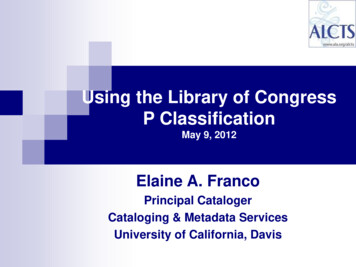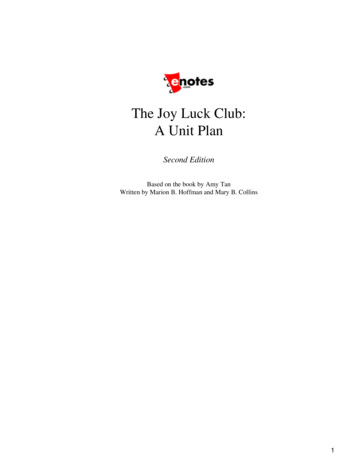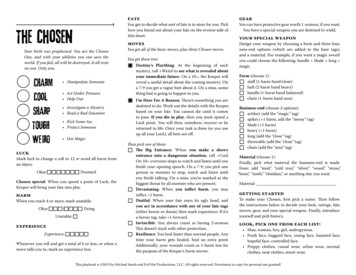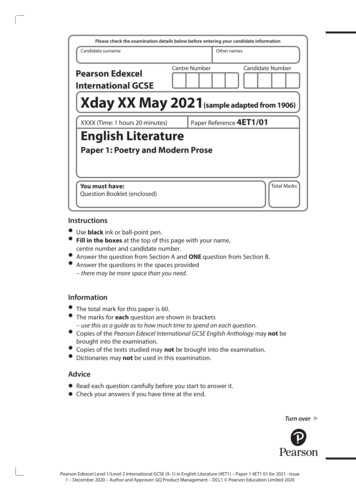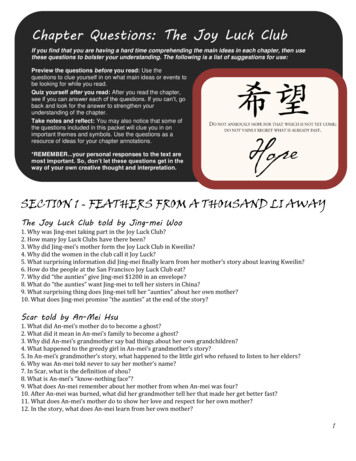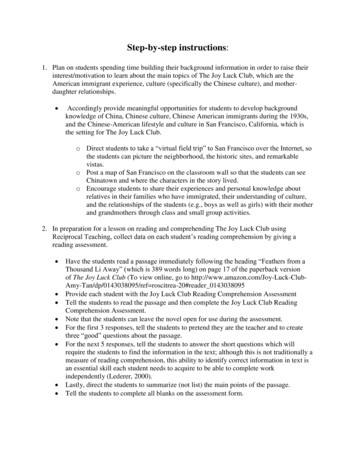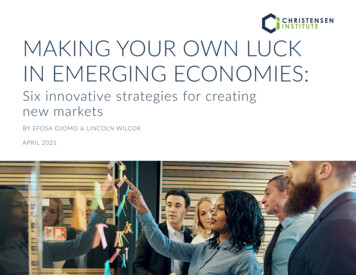
Transcription
MAKING YOUR OWN LUCKIN EMERGING ECONOMIES:Six innovative strategies for creatingnew marketsBY EFOSA OJOMO & LINCOLN WILCOXAPRIL 2021
TABLE OF CONTENTSExecutive summary3Introduction4New markets: The engine of sustainable prosperitySix strategies to mitigate risks and overcome challenges47Challenge: Designing a product customers will embrace7Strategy 1. Reduce the barriers to consumption8Strategy 2. Consider breakthrough technology to open up new possibilities(but don’t wait around for it)9Challenge: Creating a new market from scratch10Strategy 3. Develop a new value network11Strategy 4. Integrate internally12Strategy 5. Integrate externally14Challenge: Managing a difficult business environmentStrategy 6. Manage government relations1617Conclusion19Appendix20Notes23About the Institute, About the authors26CHR IS T ENSEN INS T I T U T E: M A K IN G YOUR OWN LUCK IN EMERG IN G ECON OMIE S 2
EXECUTIVE SUMMARYIt’s a widely acknowledged truth that innovation plays a pivotal role in shaping the economic fabric of nations. In particular,market-creating innovations—which create new markets by democratizing access to previously exclusive products—havebeen a vital force for generating prosperity in wealthy countries, and are integral for building a prosperous future for today’semerging economies.In order to create new markets for people who have traditionally beenunable to purchase commercial products due to barriers like cost andaccess, organizations not only need to develop a product that meetstheir customers’ needs, but must also develop a way to get it to them.This involves creating jobs and building infrastructure that wouldn’t benecessary if the organization were targeting existing markets. Lastingprosperity follows—for the organizations creating new markets and theregions and societies where they operate.In fact, they tend to employ common strategies in the ways they overcomebroad challenges:But here’s the problem. As important as market-creation is for economies,and indeed organizations, the phenomenon still remains, in large part, amystery. Successful attempts are often attributed to the luck and timingof the entrepreneur. Consequently, starting new ventures, particularly inemerging markets where many market-creating opportunities lie, appearsinordinately risky, causing would-be entrepreneurs and investors to shyaway from creating new and impactful businesses.3. Developing a new value network: 100% of organizations redefinedtheir business activities and cost structure in order to reach newconsumers while still ensuring a path to profitability.In order to demystify the process of building market-creating innovations,we studied 100 market-creating organizations that we have identified as“successful”—meaning their efforts have focused on creating sustainablenew markets that serve ignored populations of consumers. Spanninghistory, industry, and the globe, organizations profiled include globalpowerhouses such as Ford with its Model T car and Sony with its Walkman;as well as modern-day pioneers that show immense promise.Despite the diversity of organizations studied, the results revealed thatsuccessful market-creating organizations have much more in common thansimply luck, good timing, or the hard work of the innovators behind them.1. Reducing the barriers to consumption: 95% of the organizations westudied reduced more than one of the following barriers: money, time,access, and or skill.2. Employing breakthrough technology: 55% used business models thatemployed novel technology not conventionally used in the industry.4. Integrating internally: 84% took on operations in-house that areconventionally outsourced to industry partners.5. Integrating externally: 47% of organizations undertook projectstypically handled by the state.6. Managing government relations: 57% devoted significant time andenergy to managing relations with the state.The encouraging findings of this research reveal that market-creatingorganizations have far more control over their destiny than many previouslyimagined. By using the strategies outlined in this research as guideposts,innovators can, to a large degree, make their own luck. In doing so, theystand to not only generate significant wealth for themselves, but alsotrigger shared prosperity in nations where many live in poverty.CHR IS T ENSEN INS T I T U T E: M A K IN G YOUR OWN LUCK IN EMERG IN G ECON OMIE S 3
INTRODUCTIONIn the early 1850s, Isaac Singer was often shown the door the moment he brought uphis idea to make sewing machines accessible to average Americans.1 There was justno way it would work, many investors reasoned. Sewing machines were expensiveproducts reserved for highly skilled professionals. If by some miracle there wasdemand for his sewing machines, how would Singer manufacture, distribute, andsell them? Considering the fact that he would have to build this entire businessinfrastructure for a market that didn’t yet exist, it seemed impossible.With the benefit of hindsight, we know that his I.M. Singer & Co. was wildly successful at creating anew market for sewing machines. In fact, Singer’s company did so well that he expanded to Europe,Asia, and Africa, becoming one of the world’s first truly multinational private companies.Singer’s story is far from unique. In the early 1900s, when Henry Ford decided to transform hiscompany to one that made cars affordable to the masses, several of his investors pulled out.2Only wealthy Americans drove, and the infrastructure to make car ownership practical—roads, gasstations, auto repair shops, traffic regulations, and so on—didn’t widely exist. But, just like Singer,Ford successfully built a company that made the automobile affordable and accessible to millions ofpeople. And the new market created by his Model T triggered widespread prosperity for many.There are many more examples of entrepreneurs and organizations that have created new markets inthe most unlikely of circumstances. Citroen developed the 2CV, a car that enabled average people inwar-torn France to buy and use automobiles for the first time following the devastation of the Firstand Second World Wars; Mo Ibrahim built Celtel (now Airtel) which made mobile phones accessible totens of millions of Africans; Narayana Healthcare made high-end surgeries affordable to low-incomeearners in India; and Kenyan telecommunications company Safaricom built M-Pesa to become oneof the world’s most robust mobile money platforms. These are all examples of a particular type ofinnovation we call market-creating innovation.New markets: The engine of sustainable prosperityMarket-creating innovations transform complicated and expensive products into ones that aresimple and affordable so they become accessible to a whole new population of people who werepreviously excluded from consuming them. We call these people nonconsumers. For example,CHR IS T ENSEN INS T I T U T E: M A K IN G YOUR OWN LUCK IN EMERG IN G ECON OMIE S 4
Singer took something that was previously expensive, complicated, andtime-consuming—the sewing machine—and made it simple and affordableenough for average people to buy and use.T, Sony with its Walkman, and I.M. Singer & Co. with its Singer sewingmachine—as well as younger companies that show immense promise todo so.But beyond democratizing access to products and services that peoplewant and need, market-creating innovations have a unique capabilityto transform economies. When an innovator develops a product thatserves nonconsumers, she must also develop a way to get it to them. Thisinvolves creating new jobs and building new infrastructure that wouldn’tbe necessary if her organization were targeting existing markets andcompeting for existing consumers.3 In contrast with many government- orphilanthropy-led efforts to build infrastructure, which often go unfinisheddue to lack of funding4 or saddle struggling governments with cripplingdebt, market-creating innovations provide a sustainable mechanism forpulling infrastructure and jobs into an economy.5 When infrastructure isbuilt to sustain a market, stakeholders who benefit from the market areincentivized to maintain it. It’s this phenomenon that makes market-creatinginnovations an enduring engine of prosperity in society. When they createprofitable new markets, lasting prosperity follows.6Our research centered on a single question: what common strategies havethese trailblazers employed to reduce the risk inherent in market-creationand to increase their odds of success? In order to better understand thecircumstances in which certain strategies of the market creation processare important, we studied organizations and innovations throughout timeand across the globe.But here’s the problem. As important as market creation is for organizationsand economies, the phenomenon still remains, in large part, a mysterywith successful attempts often attributed to the luck and timing of theentrepreneur. Consequently, starting new ventures in emerging-marketsappears inordinately risky, causing many would-be entrepreneurs andinvestors to shy away from creating new and impactful businesses.7In order to demystify the process of building market-creating innovations,we studied 100 market-creating organizations that we have identifiedas “successful”—meaning they have focused on creating sustainable newmarkets that serve ignored populations of nonconsumers. Included in thestudy are organizations that successfully created new markets that addressor addressed nonconsumption at the time—such as Ford with its ModelOur research centered on a single question:what common strategies have trailblazersemployed to reduce the risk inherentin market-creation and to increase theirodds of success?Founding dates for these organizations go as far back as the early 1700s,and they represent an array of industries, including consumer electronics,automotive, healthcare, insurance, education, retail, transportation, andmany others (see Figure 1). Some of these innovations helped shape theeconomic fortunes of what have become the world’s most prosperouscountries, while others are modern-day pioneers that show promise to dothe same for many of today’s emerging economies.CHR IS T ENSEN INS T I T U T E: M A K IN G YOUR OWN LUCK IN EMERG IN G ECON OMIE S 5
Figure 1. Scope of market-creating organizations studiedCountries of operationIndustries representedBy the entedFounding years:1706–2018CHR IS T ENSEN INS T I T U T E: M A K IN G YOUR OWN LUCK IN EMERG IN G ECON OMIE S 6
SIX STRATEGIES TO MITIGATE RISKSAND OVERCOME CHALLENGESDespite the diversity of organizations studied, the results revealed that marketcreating organizations have much more in common than simply luck, good timing, orhard work. In fact, they tend to employ common strategies in the ways they overcomeobstacles and develop their organizations.While many factors contribute to successfully creating a new market, the research revealed sixstrategies commonly employed by market-creating organizations.8 These strategies fall into threecategories based on the broad challenges entrepreneurs face when creating new markets:1. Designing a product customers will embrace2. Creating a new market from scratch3. Managing a difficult business environmentIn this paper, we will illustrate the six strategies we observed that innovators often use to successfullyovercome these challenges. These strategies can act as guideposts to those seeking to blaze theirown trail today.Challenge: Designing a product customers will embraceEvery day people around the world go without products or services they would benefit from using.A person with diabetes might forgo needed medical consultations because they are too timeconsuming and difficult to schedule, or a person living in a low- or middle-income country mightgo without electricity because existing solutions on the market are too expensive. These individualspersist in their struggles because some kind of barrier renders good solutions difficult or impossibleto consume.Successful organizationsmake a concerted effortto understand and reducethe barriers facing theirprospective customers,sometimes with the help ofbreakthrough technology.In order to convince nonconsumers to embrace a new solution when they’re accustomed to goingwithout, our research revealed that successful organizations make a concerted effort to understandand reduce the barriers facing their prospective customers, sometimes with the help of breakthroughtechnology (see Figure 2).CHR IS T ENSEN INS T I T U T E: M A K IN G YOUR OWN LUCK IN EMERG IN G ECON OMIE S 7
Figure 2. Strategies for designing a product customers will embraceStrategyDefinitionPrevalence among100 organizations1. Reduce the barriersto consumptionThe organization reduced more than one of thebarriers to consumption: money, access, time,and skill.95%1a. Reduce themoney-related barrierThe organization made the product or serviceless expensive so nonconsumers couldafford it.80%1b. Reduce theaccess-related barrierThe organization made the product or serviceavailable to nonconsumers at a convenientlocation, enabling consumers to access it.70%1c. Reduce thetime-related barrierThe organization made buying and using theproduct or service less time-consuming sononconsumers could consume it.52%1d. Reduce theskill-related barrierThe organization made the product or servicesimple enough for nonconsumers to buy anduse it on their own.34%The organization’s business model relied onnovel technology not conventionally used inthe industry.55%2. Employ breakthroughtechnologyStrategy 1. Reduce the barriers to consumptionPrevious research has revealed a framework for helping innovators understand the four majorbarriers to consumption: money, access, time, and skill.9 Among the diverse set of market-creatingorganizations we studied, understandably, all needed to overcome at least one of these four barriersto consumption, while 95% needed to overcome multiple barriers at once. As in all aspects of themarket-creation process, circumstances matter.Money-related barriers were the most frequently encountered by the organizations in the study,and this held true across companies operating in countries of varying income levels (see Figure A2in the appendix). The other three barriers—access, time, and skill—commonly proved necessary fororganizations to overcome as well (see Figure A3 in the appendix for examples). What’s clear is thatall market-creating organizations must consider and remove the barriers so nonconsumers may beginconsuming their products.10CHR IS T ENSEN INS T I T U T E: M A K IN G YOUR OWN LUCK IN EMERG IN G ECON OMIE S 8
The process for discovering and reducing customers’ barriers to consumptionrequires a keen understanding of customers’ struggles and, often, a degreeof trial and error. To illustrate, consider how MicroEnsure, an organizationthat provides insurance for people in Africa and Asia, discovered and thenovercame all four barriers in its efforts to create a new market during theearly 2000s.However, access and money-related barriers were not the only obstaclescausing the nonconsumption of insurance; time and skill-related barrierswere at play, too. Many of the customers MicroEnsure hoped to servedidn’t have the literacy skills to read lengthy insurance contracts, and oftenlacked photo IDs and other documentation. This made registering forinsurance complex and time-consuming.For many living in emerging economies, falling into poverty is often oneunforeseen life event away.11 However, despite this reality, access toinsurance products that can help mitigate financial setback is very limited.12For instance, more than half the countries in sub-Saharan Africa have aninsurance penetration rate of less than 1%.13 Globally, more than half theworld’s population cannot afford essential healthcare.14 Richard Leftley,MicroEnsure’s founder, made it his life mission to solve this problem.Leftley and his team boiled the process down to three questions that tookless than a minute to answer: the customer’s name, age, and next of kin.Even so, they found that many customers still had difficulty filling out thequestionnaire on their own. “We could track where people gave up,” Leftleyrecalled during an interview several years ago. “Those three questionscaused 80% of the people to not complete the process.”16 MicroEnsureeventually got rid of the questions altogether, instead relying on a singlepiece of information: the customer’s phone number.Two barriers causing nonconsumption of insurance were obvious to Leftley:it cost too much and was difficult to access in too many places. Leftleyovercame these barriers by partnering with mobile telecommunicationcompanies, which had already penetrated many emerging markets.Rather than requiring customers to purchase insurance through aconventional network of sales agents that would take years to assemble,Leftley and his mobile network partners developed a model in whichcustomers could simply purchase it along with their cellular subscriptionplans. Piggybacking on mobile telecommunication companies’ wellestablished sales networks allowed MicroEnsure to reach customers inconvenient locations close to their homes, thus efficiently overcomingthe barrier of access. Customers gained basic insurance for free whenpurchasing mobile credits, and could add family members or increase theircoverage for a small fee.15 MicroEnsure received a commission of thesesales, operating as a middleman between mainstream insurers, who gainednew customers, and mobile phone companies, who gained a new revenuestream. This innovative business model allowed all parties involvedto benefit.The benefits of simplifying the sign-up process far outweighed the riskfor MicroEnsure, which registered 1 million new customers on the firstday it offered a new life insurance product in India. Tens of millions morehave joined since, more than 85% of whom have never used an insuranceproduct before MicroEnsure.17 What’s more, MicroEnsure has already beenprofitable in 80% of the markets it has entered, and has contributed newtax revenue to local governments. However, it wasn’t until it eliminatedall four barriers to consumption that the innovative company was able tocreate a new market for insurance products.Strategy 2. Consider breakthrough technology to open up new possibilities(but don’t wait around for it)Innovation is often associated with cutting-edge technology, but whetheroperating in the 18th, 19th, 20th, or 21st century, just 55% of the marketcreating organizations studied harnessed technology considered novel intheir industries at the time.CHR IS T ENSEN INS T I T U T E: M A K IN G YOUR OWN LUCK IN EMERG IN G ECON OMIE S 9
The research revealed valuable insights about both why breakthrough techis beneficial as well as when it’s unnecessary. New technologies tend to beuseful when they radically impact a barrier to consumption.At the beginning of the 20th century in America, Henry Ford harnessednew technologies like the manufacturing assembly line and the internalcombustion engine to make cars affordable and accessible for averageAmericans. In modern times, internet and mobile phones have enabledMicroEnsure to make insurance affordable and accessible, and allowedmobile money companies like M-Pesa to bring affordable financial servicesto millions who had no way to access them before. Additionally, solartechnology has been vital for helping energy companies like M-Kopamake electricity vastly more accessible in rural communities far away fromconventional electrical grids. When widespread breakthrough technologieslike these come into existence, they often unlock opportunities for newmarkets that didn’t exist before.However, innovators shouldn’t just wait around for new technology to bedeveloped—there are usually plenty of opportunities to create new marketsusing technology that’s already available. Oftentimes, taking a simple, lowtech approach is just as effective as a high-tech one. The real insight is thatbreakthrough technology is a means for more efficiently addressing thestruggle in nonconsumers’ lives. When low-tech solutions accomplish thesame thing, innovators shouldn’t shy away from them.Breakthrough technology is a means formore efficiently addressing the strugglein nonconsumers’ lives. When low-techsolutions accomplish the same thing,innovators shouldn’t shy away from them.Low-tech, high-impactHavaianas, which makes and sells sandals, created a new marketfor footwear in Brazil in the 1960s by developing a remarkablyuncomplicated rubber flip-flop that rapidly became the go-tofootwear for the majority of Brazil’s lower-income citizens.18 Infact, it was precisely the lack of bells and whistles that madeHavaianas sandals affordable enough for nonconsumers to beginconsuming them. In contrast to conventional shoes which werecomplicated and time-consuming to construct, Havaianas werecomposed of a flat rubber footbed attached to a one-piece strap,making them cheap and quick to manufacture.Similarly, at a time when ox-drawn carts dominated Korea’stransportation scene, Kia Motors built a new market forautomobiles by creating a simplified, three-wheeled vehiclesuited for the practical and financial circumstances of averageKoreans.19 For Havaianas, Kia, and many other companies inthe study, taking a simple, low-tech approach proved effectiveenough to help organizations build a new market.Challenge: Creating a new market from scratchUnderstanding the barriers that inhibit consumption helps organizationsto create a solution that works for nonconsumers. The next challenge iscreating a new market that can deliver that product or service to customersprofitably, enabling the organization to become sustainable and scalable.Building a market from the ground up requires creativity. The results from ourstudy highlight three strategies common to market-creating organizationsthat have served nonconsumers: develop a new value network, integrateinternally, and integrate externally (see Figure 3).C H R I S T EN S EN I N S T I T U T E : M A K I N G YO U R OW N LU C K I N EM ERG I N G ECO N O M I E S 10
Figure 3. Strategies for creating a new market from scratchInnovators aiming to servenonconsumers need to redefinetheir business activities and coststructure so that nonconsumerscan afford their product—whilestill offering their organization apath to profitability.StrategyDefinitionPrevalence among100 organizations3. Develop a new value networkThe organization redefined its businessactivities and cost structure so thatnonconsumers could more conveniently accessits product, while still offering the organizationa path to profitability.100%4. Integrate internallyThe organization integrated operationsin-house that are conventionally outsourced inthe industry (i.e., producing the raw materialsused in its products).84%5. Integrate externallyThe organization undertook infrastructureprojects typically supplied by the state (i.e.,electricity, roads).47%Strategy 3. Develop a new value networkA value network is the aggregation of all the activities that must take place in order for a customer tobuy and use a product. These activities might include design, purchase of raw materials, manufacturing,distribution, sales and marketing, and after-sales services like repairs or customer service. Each stepin a value network adds some value to the product, but it also adds cost.Results from our study revealed that, across time and in all the various regions where these marketcreating organizations operated, every last one had to build a new value network. That’s becauseconventional value networks in many industries prevent companies from meeting the needs ofnonconsumers, typically by adding too much cost to the product or limiting its accessibility in otherways. Consequently, innovators aiming to serve nonconsumers need to redefine their businessactivities and cost structure so that nonconsumers can afford their product. And innovators must doall this while still offering their organization a path to profitability.Organizations can create new value networks in different ways. MicroEnsure managed to makeinsurance affordable and accessible by introducing mobile phone companies into its value network,while other companies built new value networks from scratch.Galanz, now a world leader in home appliance manufacturing, built a new value network from theground up in the early 2000s when it created a new market for affordable microwave ovens in China.C H R I S T EN S EN I N S T I T U T E : M A K I N G YO U R OW N LU C K I N EM ERG I N G ECO N O M I E S 11
Since other Chinese manufacturers tended to focus on export markets,Galanz built showrooms and developed distribution lines within Chinato get its products to local customers (see Figure 4). Within two years ofbeginning production, it had created a national sales network of almost5,000 stores. It even opted to advertise through newspapers instead of TV,thus saving money and enabling it to instruct many first-time customers onhow to use microwaves.20operate in unpredictable environments, but also due to their need to servenonconsumers who have been ignored by conventional companies. It’sunrealistic that any entrepreneur, no matter how savvy or in tune withlocal people, will perfectly understand the needs of these nonconsumersfrom the outset. Instead, the path to success requires openness, flexibility,and many iterations to zero-in on how best to address the problemsnonconsumers want solved.21Figure 4. Value networks for microwave ovensConventional value network for Chinese microwave ovensManufacturingExport shippingThe path to success requires openness,flexibility, and many iterations tozero-in on how best to address theproblems nonconsumers want solved.New value network for GalanzStrategy 4: Integrate internallyProduct design& developmentManufacturingAdvertising& marketingDistribution& retail(within China)After-salesservice &supportInnovators creating new markets need to operate with the expectationthat their final business will look different from the one they envisionedon the day they founded their company. Just as every organization westudied created a new value network, it was equally true that not one ofthem followed an entirely predictable, deliberate strategy from day one.This is due not only to the fact that organizations building new marketsAlmost all—84%—of the organizations studied needed to internallyintegrate operations that are typically outsourced by other companies.To successfully develop a new market, organizations chose to developoperations in-house that conventional companies did not see as core totheir business.22For example, a typical computer company in a mature market might sourcecomponent parts from several suppliers, use a shipping company totransport its products to retailers, and rely on those retailers for sales andrepair services. This is standard practice in business as it enables companiesto focus on their core competencies.23CHR IS T ENSEN INS T I T U T E: M A K IN G YOUR OWN LUCK IN EMERG IN G ECON OMIE S 12
However, because market-creating organizations, as the name suggests,are creating new markets, the firms a company might outsource operationsto often don’t exist or are unreliable. Therefore, in order to reliably delivertheir product, market-creating organizations usually need to developmany of these typically “outsourceable” operations in-house. The researchrevealed this phenomenon to be especially prominent among companiesoperating in lower-income markets; but even in high-income countries,two-thirds of market-creating organizations internally integrated in orderto create a new market (see Figure 5).Figure 5. Prevalence of internal integration across countries of varyingincomes100%Similarly, in the 1980s and 1990s, Aravind Eye Hospitals, a network ofaffordable, high-quality eye clinics in India, found that two critical inputs ofits value network—intraocular lenses needed for surgery and well-trainedtechnicians—were difficult to reliably and affordably obtain. In order todeliver its service, the organization was forced to look beyond its corecompetency of performing eye surgeries and began manufacturing its ownlenses and training its own technicians. These moves cut costs, increasedreliability, and enabled Aravind to perform 400,000 low-cost or free eyesurgeries annually.27The lessons learned by managers at Grupo Bimbo and Aravind Eye Hospitalapply to all who create and lead market-creating organizations. (For moreexamples, see Figure 6.) Innovators need to shift their focus beyond theircompany’s core competencies and consider the entire value network of theirproducts and services. After identifying where in the market capabilities tomanage those activities are unreliable or missing altogether, innovators canthen develop those operations in-house.80%60%40%20%0%the decades that followed, the company integrated agriculture, financialservices, distribution and logistics, packaging, and more into its operations.Grupo Bimbo even developed its own two-year educational program tosupplement its employees’ education and train managers.26Low income(n 25)Lower-middleincome (n 44)Upper-middleincome (n 22)High income(n 9)Country of operationGrupo Bimbo, now the world’s largest baking company, began as a smallventure aiming to create a new market for affordable fresh bread inMexico City in 1945.24 At the time, Mexico was a very poor country, andfresh bread was a luxury for many.25 As Grupo Bimbo grew, its leadersrecognized that to guarantee a predictable supply of quality flour for itsbakeries, the company needed to develop its own flour mills. This wasjust the beginning of Grupo Bimbo’s internal integration activities. InInnovators need to shift their focus beyondtheir company’s core competenciesto identify which operations are bestdeveloped in-house.CHR IS T ENSEN INS T I T U T E:
MAKING YOUR OWN LUCK IN EMERGING ECONOMIES: . and are integral for building a prosperous future for today’s emerging economies. . including consumer electronics, automotive,healthcare, insurance, education,retail, transportation,and many others
